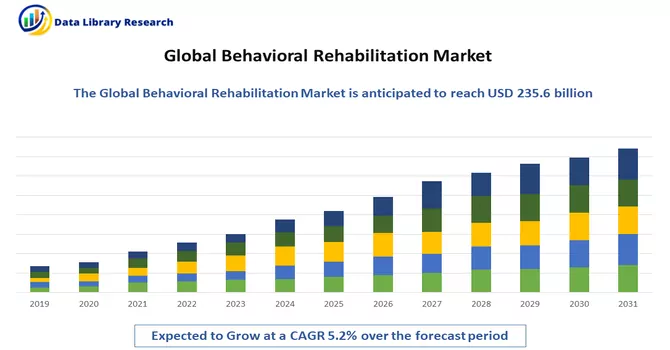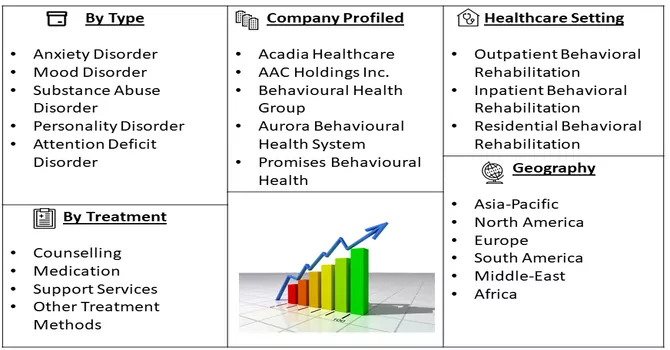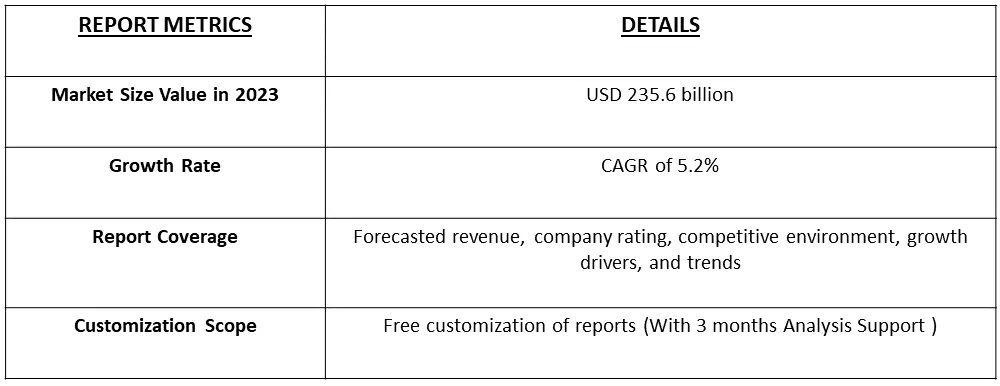The Behavioral Rehabilitation Market size is expected to grow from USD 235.6 billion in 2023 and expected to register a CAGR of 5.2% during the forecast period (2023-2030).

Get Complete Analysis Of The Report - Download Free Sample PDF
Behavioral rehabilitation refers to a therapeutic and multidisciplinary approach aimed at addressing and modifying maladaptive behaviors, emotional challenges, and mental health disorders in individuals. The focus is on helping individuals develop healthier coping mechanisms, adaptive behaviors, and improved emotional well-being. This form of rehabilitation is often utilized for conditions such as substance abuse, addiction, mood disorders, anxiety disorders, and various behavioral issues.
The market is experiencing substantial growth driven by several key factors, including the increasing prevalence of behavioral disorders and the expanded availability of therapeutic interventions. The rise of online counseling, a growing preference for partial hospitalization programs (PHP), and heightened government initiatives are also significant contributors to this upward trend.
The integration of virtual and telehealth services in behavioral rehabilitation is a prominent trend. This facilitates remote access to therapy sessions, counseling, and support, providing individuals with more flexible and convenient mental health care options. The advent of digital therapeutics is reshaping behavioral rehabilitation. Mobile applications, wearable devices, and virtual reality platforms are being leveraged to deliver therapeutic interventions, enhancing engagement and providing continuous support. Thus, these market trends is expected to flourish the market growth over the forecast period.
Market Segmentation: The Behavioral Rehabilitation Market is Segmented by Type of Behavioral Disorder (Anxiety Disorder, Mood Disorder, Substance Abuse Disorder, Personality Disorder, and Attention Deficit Disorder), Healthcare Setting (Outpatient Behavioral Rehabilitation, Inpatient Behavioral Rehabilitation, and Residential Behavioral Rehabilitation), Treatment Method (Counselling, Medication, Support Services, and Other Treatment Methods), and Geography (North America, Europe, Asia-Pacific, Middle-East and Africa, and South America). The market provides the value (in USD million) for the above-mentioned segments.

For Detailed Market Segmentation - Download Free Sample PDF
Market Drivers:
Growing Prevalence and Availability of Therapies for Behavioral Rehabilitation and Advent of Online Counselling
There is a noticeable surge in global awareness surrounding behavioral disorders, leading to an increased recognition of mental health challenges. The growing acknowledgment of the prevalence of conditions such as anxiety, depression, and substance abuse has created a heightened demand for effective behavioral rehabilitation. Moreover, mental health advocacy initiatives worldwide are contributing to reducing stigma and fostering open conversations about behavioral disorders. As a result, more individuals are seeking help, thereby driving the need for accessible and diverse behavioral rehabilitation therapies. The landscape of behavioral rehabilitation therapies is expanding, offering diverse and personalized approaches to address a spectrum of mental health concerns. Therapies include cognitive-behavioral therapy (CBT), dialectical behavior therapy (DBT), mindfulness-based interventions, and more, providing tailored solutions to individual needs. Thus, owing to such benefits, the market is expected to witness significant growth over the forecast period.
Increasing Preferences for Partial Hospitalization Programs (PHP) and Rising Government Initiatives
In recent years, there has been a noticeable shift in treatment preferences towards Partial Hospitalization Programs (PHP). PHPs offer a structured and comprehensive treatment approach, providing individuals with intensive therapeutic interventions during the day while allowing them to return home in the evenings. This model combines the intensity of inpatient care with the flexibility of outpatient settings. Governments around the world are increasingly recognizing the importance of mental health and the need for robust behavioral rehabilitation services. The rising prevalence of behavioral disorders has prompted governments to prioritize mental health initiatives, allocating resources to enhance the accessibility and quality of mental health services. Thus, owing to such benefits, the market is expected to witness significant growth over the forecast period.
Market Restraints:
Lack of Awareness Regarding Behavioral Disorders and Impact of Stigma on People with Behavioral Disorders
The behavioral rehabilitation market faces a significant hurdle in its growth trajectory due to the lack of awareness regarding behavioral disorders and the pervasive impact of stigma on individuals grappling with such conditions. A prevailing challenge is the limited understanding of behavioral disorders among the general public. Many individuals may lack awareness of the diverse range of conditions encompassed by behavioral disorders, leading to a gap in recognizing the signs and seeking appropriate treatment. The combined effect of lack of awareness and stigma leads to reduced demand for behavioral rehabilitation services. The market, poised to address the growing mental health needs, experiences a slowdown as individuals remain uninformed about available interventions or are hesitant to seek assistance. Thus, these factors are expected to slow the growth of the studied market over the forecast period.
The market underwent substantial changes due to the impact of the COVID-19 pandemic. The surge in COVID-19 cases and heightened anxiety among the general population resulted in a noticeable uptick in conditions such as anxiety and stress. Notably, a scientific brief released by the World Health Organization (WHO) in March 2022 revealed a remarkable 25% increase in the global prevalence of anxiety and sadness during the first year of the COVID-19 pandemic. The brief delves into the demographic groups most affected by the pandemic, highlighting shifts in the availability of mental health treatments over time. In response to the heightened mental health challenges, the American federal government took proactive measures in September by allocating approximately USD 8 billion in COVID-19 relief funds specifically for behavioral health. These funds were primarily channeled through grant programs, prioritizing support for those at higher risk.
Consequently, these initiatives, coupled with the escalating prevalence of mental disorders, underscore the substantial impact of the COVID-19 pandemic on the market. The market underwent substantial changes due to the impact of the COVID-19 pandemic. The surge in COVID-19 cases and heightened anxiety among the general population resulted in a noticeable uptick in conditions such as anxiety and stress. Notably, a scientific brief released by the World Health Organization (WHO) in March 2022 revealed a remarkable 25% increase in the global prevalence of anxiety and sadness during the first year of the COVID-19 pandemic. The brief delves into the demographic groups most affected by the pandemic, highlighting shifts in the availability of mental health treatments over time.
In response to the heightened mental health challenges, the American federal government took proactive measures in September by allocating approximately USD 8 billion in COVID-19 relief funds specifically for behavioral health. These funds were primarily channeled through grant programs, prioritizing support for those at higher risk. Consequently, these initiatives, coupled with the escalating prevalence of mental disorders, underscore the substantial impact of the COVID-19 pandemic on the market.
Moreover, the pandemic served as a catalyst for increased awareness about mental health. This heightened awareness is anticipated to drive market growth during the forecast period, as a more informed and engaged public seeks and prioritizes mental health services. The intersection of government interventions, rising mental health concerns, and a broader societal acknowledgment of the importance of mental well-being collectively signifies the transformative impact of the COVID-19 pandemic on the studied market.
Segmental Analysis:
Anxiety Disorder Segment is Expected to Witness Significant Growth Over the Forecast Period
Anxiety disorders represent a spectrum of mental health conditions characterized by excessive worry, fear, or apprehension. Individuals grappling with anxiety disorders often experience symptoms that impact their daily lives, ranging from generalized anxiety to specific phobias, panic disorders, and social anxiety. The prevalence of anxiety disorders is a global concern, necessitating comprehensive approaches for diagnosis, treatment, and rehabilitation. The global rise in anxiety disorders has spurred the demand for effective rehabilitation services. Societal stressors, lifestyle changes, and heightened awareness have collectively contributed to the growing prevalence of anxiety-related conditions.
Moreover, the integration of technology in mental health rehabilitation has opened new avenues for personalized and accessible care. Digital therapeutics, telehealth solutions, and mobile applications play a crucial role in providing ongoing support and intervention for individuals dealing with anxiety disorders. Thus, due to the above-mentioned advantages, the segment is expected to witness significant growth over the forecast period.
Outpatient Behavioral Rehabilitation Segment is Expected to Witness Significant Growth Over the Forecast Period
Outpatient behavioural rehabilitation is a vital component of mental health care that extends therapeutic support to individuals while allowing them to maintain their daily lives and routines. Unlike inpatient programs, outpatient services provide flexibility, enabling individuals to receive treatment without the need for residential stays. Compared to inpatient programs, outpatient rehabilitation is often more cost-effective. This makes mental health treatment more accessible to a broader range of individuals. Outpatient care enables individuals to maintain their independence and autonomy. They can continue with their daily routines and responsibilities, fostering a sense of normalcy. Thus, owing to the above-mentioned reasons the segment is expected to witness significant growth over the forecast period.
Counselling Segment is Expected to Witness Significant Growth Over the Forecast Period
The counseling and behavioral rehabilitation market plays a pivotal role in addressing the multifaceted challenges of mental health. This dynamic sector encompasses a range of services aimed at promoting emotional well-being, fostering resilience, and supporting individuals in overcoming behavioral health issues. Individual counseling forms the foundation of the market, offering personalized therapeutic sessions tailored to the unique needs of each individual. This one-on-one approach allows for focused exploration and resolution of specific mental health concerns. Increasing awareness and destigmatization of mental health issues have contributed to a growing demand for counseling and behavioral rehabilitation services. Individuals are more inclined to seek support, fostering a positive trend in mental health care utilization. Thus, the segment is expected to witness significant growth over the forecast period.
North America Region is Expected to Witness Significant Growth Over the Forecast Period.
North America is anticipated to be a significant player in the behavioral rehabilitation market throughout the projected period. The United States, in particular, holds a substantial share in this market. Over the past decade, several mental health rehabilitation centers have been established in developed countries like the United States and Canada due to the increasing prevalence of mental health issues. Notably, recent data from the CDC in November 2022 revealed that approximately 31.7% of adults in the United States experienced mental illness in October 2022, with 1 in 5 adults facing mental health challenges each year. This surge in mental health concerns has prompted the integration of physical and behavioral patient data, presenting an opportunity for providers to enhance health outcomes through integrated care.
Moreover, market players are actively launching new initiatives in the behavioral health sector. For example, Happify Inc. introduced Ensemble in July 2021, a transdiagnostic prescription digital therapeutic designed for individuals aged 22 and older dealing with major depressive disorder (MDD) or generalized anxiety disorder (GAD). The introduction of such therapeutic solutions for mental health disorders is expected to contribute to robust growth in the United States. Additionally, there is a notable focus on mental health awareness and management by the U.S. government. An instance of this is the mental health initiative launched by the United States Tennis Association (USTA) in August 2021 to support players. Government initiatives, including the Affordable Care Act that categorizes behavioral disorders as essential healthcare, contribute to covering a significant portion of treatment costs, thereby fostering the growth of the market in the region.

Get Complete Analysis Of The Report - Download Free Sample PDF
The market exhibits a mild consolidation, primarily dominated by a handful of key players. Presently, numerous companies are directing their efforts toward the creation and launch of innovative, cost-effective, and easily accessible products and services. Additionally, these entities are actively engaging in strategic collaborations and partnerships to strengthen their positions within the market. Among the notable market players are:
Recent Developments :
1) In October 2022, the Biden-Harris Administration revealed that it secured approximately USD 300 million in funding to support both new and established Certified Community Behavioral Health Clinics.
2) In October 2022, the Government of India declared its plans to introduce a National Tele-Health initiative specifically tailored for mental health services.
Q1. What was the Behavioral Rehabilitation Market size in 2023?
As per Data Library Research the Behavioral Rehabilitation Market size is expected to grow from USD 235.6 billion in 2023.
Q2. At what CAGR is the Behavioral Rehabilitation Market projected to grow within the forecast period?
Behavioral Rehabilitation Market is expected to register a CAGR of 5.2% during the forecast period.
Q3. What segments are covered in the Behavioral Rehabilitation Market Report?
By Type of Behavioral Disorder, Healthcare Setting, Treatment Method and Geography are the segments covered in the Behavioral Rehabilitation Market Report.
Q4. Which region has the largest share of the Behavioral Rehabilitation Market? What are the largest region's market size and growth rate?
North America has the largest share of the market. For detailed insights on the largest region's market size and growth rate request a sample here.
Data Library Research are conducted by industry experts who offer insight on industry structure, market segmentations technology assessment and competitive landscape (CL), and penetration, as well as on emerging trends. Their analysis is based on primary interviews (~ 80%) and secondary research (~ 20%) as well as years of professional expertise in their respective industries. Adding to this, by analysing historical trends and current market positions, our analysts predict where the market will be headed for the next five years. Furthermore, the varying trends of segment & categories geographically presented are also studied and the estimated based on the primary & secondary research.
In this particular report from the supply side Data Library Research has conducted primary surveys (interviews) with the key level executives (VP, CEO’s, Marketing Director, Business Development Manager and SOFT) of the companies that active & prominent as well as the midsized organization
FIGURE 1: DLR RESEARH PROCESS

Extensive primary research was conducted to gain a deeper insight of the market and industry performance. The analysis is based on both primary and secondary research as well as years of professional expertise in the respective industries.
In addition to analysing current and historical trends, our analysts predict where the market is headed over the next five years.
It varies by segment for these categories geographically presented in the list of market tables. Speaking about this particular report we have conducted primary surveys (interviews) with the key level executives (VP, CEO’s, Marketing Director, Business Development Manager and many more) of the major players active in the market.
Secondary ResearchSecondary research was mainly used to collect and identify information useful for the extensive, technical, market-oriented, and Friend’s study of the Global Extra Neutral Alcohol. It was also used to obtain key information about major players, market classification and segmentation according to the industry trends, geographical markets, and developments related to the market and technology perspectives. For this study, analysts have gathered information from various credible sources, such as annual reports, sec filings, journals, white papers, SOFT presentations, and company web sites.
Market Size EstimationBoth, top-down and bottom-up approaches were used to estimate and validate the size of the Global market and to estimate the size of various other dependent submarkets in the overall Extra Neutral Alcohol. The key players in the market were identified through secondary research and their market contributions in the respective geographies were determined through primary and secondary research.
Forecast Model
